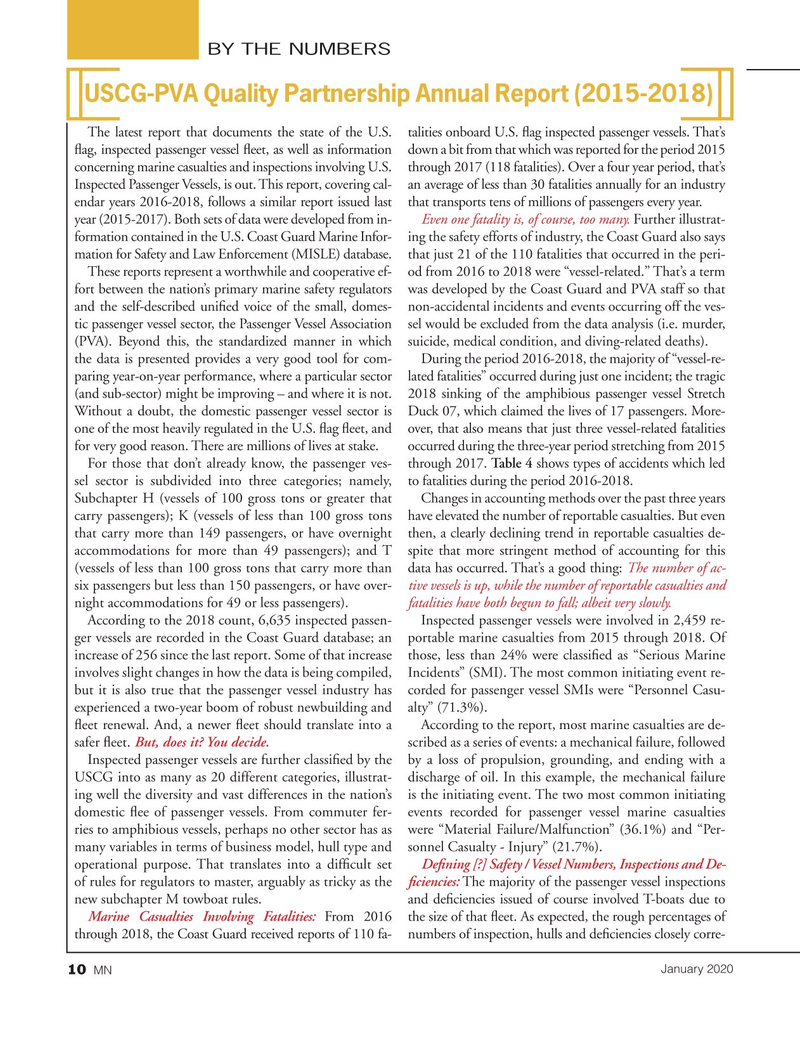
Page 10: of Marine News Magazine (January 2020)
Passenger Vessels & Ferries
Read this page in Pdf, Flash or Html5 edition of January 2020 Marine News Magazine
BY THE NUMBERS
USCG-PVA Quality Partnership Annual Report (2015-2018)
The latest report that documents the state of the U.S. talities onboard U.S. ? ag inspected passenger vessels. That’s ? ag, inspected passenger vessel ? eet, as well as information down a bit from that which was reported for the period 2015 concerning marine casualties and inspections involving U.S. through 2017 (118 fatalities). Over a four year period, that’s
Inspected Passenger Vessels, is out. This report, covering cal- an average of less than 30 fatalities annually for an industry endar years 2016-2018, follows a similar report issued last that transports tens of millions of passengers every year.
year (2015-2017). Both sets of data were developed from in- Even one fatality is, of course, too many. Further illustrat- formation contained in the U.S. Coast Guard Marine Infor- ing the safety efforts of industry, the Coast Guard also says mation for Safety and Law Enforcement (MISLE) database. that just 21 of the 110 fatalities that occurred in the peri-
These reports represent a worthwhile and cooperative ef- od from 2016 to 2018 were “vessel-related.” That’s a term fort between the nation’s primary marine safety regulators was developed by the Coast Guard and PVA staff so that and the self-described uni? ed voice of the small, domes- non-accidental incidents and events occurring off the ves- tic passenger vessel sector, the Passenger Vessel Association sel would be excluded from the data analysis (i.e. murder, (PVA). Beyond this, the standardized manner in which suicide, medical condition, and diving-related deaths).
the data is presented provides a very good tool for com- During the period 2016-2018, the majority of “vessel-re- paring year-on-year performance, where a particular sector lated fatalities” occurred during just one incident; the tragic (and sub-sector) might be improving – and where it is not. 2018 sinking of the amphibious passenger vessel Stretch
Without a doubt, the domestic passenger vessel sector is Duck 07, which claimed the lives of 17 passengers. More- one of the most heavily regulated in the U.S. ? ag ? eet, and over, that also means that just three vessel-related fatalities for very good reason. There are millions of lives at stake. occurred during the three-year period stretching from 2015
For those that don’t already know, the passenger ves- through 2017. Table 4 shows types of accidents which led sel sector is subdivided into three categories; namely, to fatalities during the period 2016-2018.
Subchapter H (vessels of 100 gross tons or greater that Changes in accounting methods over the past three years carry passengers); K (vessels of less than 100 gross tons have elevated the number of reportable casualties. But even that carry more than 149 passengers, or have overnight then, a clearly declining trend in reportable casualties de- accommodations for more than 49 passengers); and T spite that more stringent method of accounting for this (vessels of less than 100 gross tons that carry more than data has occurred. That’s a good thing: The number of ac- six passengers but less than 150 passengers, or have over- tive vessels is up, while the number of reportable casualties and night accommodations for 49 or less passengers). fatalities have both begun to fall; albeit very slowly.
According to the 2018 count, 6,635 inspected passen- Inspected passenger vessels were involved in 2,459 re- ger vessels are recorded in the Coast Guard database; an portable marine casualties from 2015 through 2018. Of increase of 256 since the last report. Some of that increase those, less than 24% were classi? ed as “Serious Marine involves slight changes in how the data is being compiled, Incidents” (SMI). The most common initiating event re- but it is also true that the passenger vessel industry has corded for passenger vessel SMIs were “Personnel Casu- experienced a two-year boom of robust newbuilding and alty” (71.3%).
? eet renewal. And, a newer ? eet should translate into a According to the report, most marine casualties are de- safer ? eet. But, does it? You decide. scribed as a series of events: a mechanical failure, followed
Inspected passenger vessels are further classi? ed by the by a loss of propulsion, grounding, and ending with a
USCG into as many as 20 different categories, illustrat- discharge of oil. In this example, the mechanical failure ing well the diversity and vast differences in the nation’s is the initiating event. The two most common initiating domestic ? ee of passenger vessels. From commuter fer- events recorded for passenger vessel marine casualties ries to amphibious vessels, perhaps no other sector has as were “Material Failure/Malfunction” (36.1%) and “Per- many variables in terms of business model, hull type and sonnel Casualty - Injury” (21.7%).
operational purpose. That translates into a dif? cult set De? ning [?] Safety / Vessel Numbers, Inspections and De- of rules for regulators to master, arguably as tricky as the ? ciencies: The majority of the passenger vessel inspections new subchapter M towboat rules. and de? ciencies issued of course involved T-boats due to
Marine Casualties Involving Fatalities: From 2016 the size of that ? eet. As expected, the rough percentages of through 2018, the Coast Guard received reports of 110 fa- numbers of inspection, hulls and de? ciencies closely corre-
January 2020 10 MN

 9
9

 11
11
